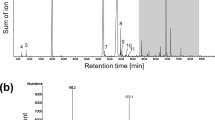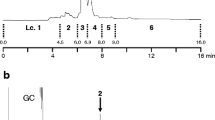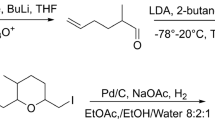Abstract
6,10,14-Trimethylpentadecan-2-one (Hexahydrofarnesyl acetone; HHA) previously has been found to be a major component in tibial fragrances of male orchid bees, Euglossa spp. HHA is a chiral molecule with four possible stereoisomers, (6R, 10R)-, (6R, 10S)-, (6S, 10R)-, and (6S, 10S)-6,10,14-trimethylpentadecan-2-one. In the present study, we characterized HHA extracted from Euglossa as the pure enantiomer (6R, 10R)-6,10,14-trimethylpentadecan-2-one. During bioassays in Mexico and Panama, the synthetic RR-isomer attracted males of six species of orchid bees, including three that were known to contain HHA in their tibial fragrances. Possible sources of HHA for wild bees are flowers of euglossophilous orchids and aroids. With a molecular weight of 268, HHA is the largest natural molecule known to attract male orchid bees in pure form. Its attractiveness to males suggests that low-volatility compounds have a function in male signals, e.g., serve as a “base note” in complex odor bouquets.


Similar content being viewed by others
References
Brooks C. J. W., Gilbert M. T., and Gilbert J. D. 1973. New derivatives for gas-phase analytical resolution of enatiomeric alcohols and amines. Anal. Chem. 45:896–902.
Dodson C. H., Dressler R. L., Hills H. G., Adams R. M., and Williams N. H. 1969. Biologically active compounds in orchid fragrances. Science 164:1243–1249.
Dressler R. L. 1968. Observations on orchids and euglossine bees in Panama and Costa Rica. Rev. Biol. Trop. 15:143–183.
Eltz T., Whitten W. M., Roubik D. W., and Linsenmair K. E. 1999. Fragrance collection, storage, and accumulation by individual male orchid bees. J. Chem. Ecol. 25:157–176.
Eltz T., Roubik D. W., and Lunau K. 2005a. Experience-dependent choices ensure species-specific fragrance accumulation in male orchid bees. Behav. Ecol. Sociobiol. 59:149–156.
Eltz T., Sager A., and Lunau K. 2005b. Juggling with volatiles: exposure of perfumes by displaying male orchid bees. J. Comp. Physiol. A 191:575–581.
Eltz T., Zimmermann Y., Haftmann J., Twele R., Francke W., Quezada-Euan J. J. G., and Lunau K. 2007. Enfleurage, lipid recycling and the origin of perfume collection in orchid bees. Proc. Roy. Soc. Lond. B Bio. 274:2843–2848.
Eltz T., Zimmermann Y., Pfeiffer C., Ramírez Pech J., Twele R., Francke W., Quezada-Euan J. J. G., and Lunau K. 2008. An olfactory shift is associated with male perfume differentiation and species divergence in orchid bees. Curr. Biol. 18:1844–1848.
Hentrich H., Kaiser R., and Gottsberger G. 2010. Floral biology and reproductive isolation by floral scent in three sympatric aroid species in French Guiana. Plant Biol. 12:587–596.
Kalinová B., Kindl J., Jiros P., Zacek P., Vasickova S., Budesinsky M., and Valterova I. 2009. Composition and electrophysiological activity of constituents identified in male wing gland secretion of the bumblebee parasite Aphomia sociella. J. Nat. Prod. 72:8–13.
Nam T.-G., Rector C. L., Kim H.-Y., Sonnen A. F. P., Meyer R., Nau W. M., Atkinson J., Rintoul J., Pratt D. A., and Porter N. A. 2007. Tetrahydro-1,8-naphthyridinol analogues of α-tocopherol as antioxidants in lipid membranes and low-density lipoproteins. J. Am. Chem. Soc. 129:10211–10219.
Ramírez S. R., Dressler R. L., and Ospina M. 2002. Abejas euglosinas (Hymenoptera: Apidae) de la región neotropical: listado de especies con notas sobre su biología. Biota Colombiana 3:7–118.
Ramírez S. R., Eltz T., Fritzsch F., Pemberton R. W., Pringle E. G., and Tsutsui N. D. 2010. Intraspecific geographic variation of fragrances acquired by orchid bees in native and introduced populations. J. Chem. Ecol. 36: 873–884.
Sasaerila Y., Gries R., Gries G., Khaskin G., King S., Takács, S., and Hardi. 2003. Sex pheromone components of male Tirathaba mundella (Lepidoptera: Pyralidae). Chemoecology 13:89–93.
Suga T., Ohta S., Nakai A., and Munesada K. 1989. Glycinoprenols: novel polyprenols possessing a phytyl residue from the leaves of soybean. J. Org. Chem. 54:3390–3393.
Vogel S. 1966. Parfümsammelnde Bienen als Bestäuber von Orchidaceen und Gloxinia. Österr. Botan. Zeit. 113:302–361.
Williams N. H., and Whitten W. M. 1983. Orchid floral fragrances and male euglossine bees: methods and advances in the last sesquidecade. Biol. Bull. 164:355–395.
Willstätter R., and Stoll A. 1913. Untersuchungen über Chlorophyll. Verlag J. Springer, 424 pp.
Zhao L., Jin C., Mao Z., Gopinathan M. B., Rehder K., and Brinton R. D. 2007. Design, synthesis, and estrogenic activity of a novel estrogen receptor modulator—a hybrid structure of 17β-estradiol and vitamin E in hippocampal neurons. J. Med. Chem. 50:4471–4481.
Zimmermann Y., Ramírez S. R., and Eltz T. 2009. Chemical niche differentiation among sympatric species of orchid bees. Ecology 90:2994–3008.
Acknowledgements
We are grateful to Falko Fritzsch and Carlos Hernandez Velez for help in the field. TE is supported by the Deutsche Forschungsgemeinschaft (EL 249/4 and 6) and EH, JB, EW and JA are grateful for the financial support from EU (Objective 2 the region of South Forest Counties) and Länsstyrelsen i Västernorrlands län.
Author information
Authors and Affiliations
Corresponding authors
Rights and permissions
About this article
Cite this article
Eltz, T., Hedenström, E., Bång, J. et al. (6R, 10R)-6,10,14-Trimethylpentadecan-2-one, a Dominant and Behaviorally Active Component in Male Orchid Bee Fragrances. J Chem Ecol 36, 1322–1326 (2010). https://doi.org/10.1007/s10886-010-9873-4
Received:
Revised:
Accepted:
Published:
Issue Date:
DOI: https://doi.org/10.1007/s10886-010-9873-4




